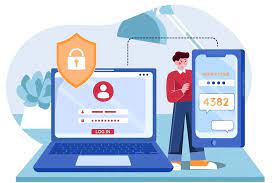Strong password and authentication practices are crucial for protecting your online accounts and preventing online fraud. Here are some recommendations to help you establish robust security measures:
- Use Unique and Complex Passwords: Create strong, unique passwords for each of your online accounts. Avoid using common or easily guessable passwords like “password123” or personal information such as your birthdate or name. Instead, use a combination of uppercase and lowercase letters, numbers, and special characters. Consider using a reliable password manager to securely store and generate complex passwords.
- Enable Multi-Factor Authentication (MFA): Whenever possible, enable multi-factor authentication for your accounts. MFA adds an extra layer of security by requiring you to provide an additional verification factor, such as a temporary code sent to your mobile device, along with your password. This helps prevent unauthorized access even if your password is compromised.
- Regularly Update and Change Passwords: Periodically update your passwords, especially for critical accounts like email, banking, and social media. Aim to change passwords at least every three to six months. Avoid reusing passwords across multiple accounts, as it increases the risk of multiple accounts being compromised if one password is breached.
- Be Wary of Phishing Attempts: Phishing is a common method used by attackers to trick users into revealing their login credentials or personal information. Be cautious of unsolicited emails, messages, or links that ask for your login details or sensitive data. Always verify the legitimacy of the sender and refrain from clicking on suspicious links.
- Keep Software and Devices Updated: Regularly update your operating system, web browsers, and applications to ensure you have the latest security patches and bug fixes. Outdated software can contain vulnerabilities that attackers can exploit to gain unauthorized access to your accounts.
- Secure Your Wi-Fi Network: Protect your home Wi-Fi network with a strong password and encryption. Use WPA2 or WPA3 encryption protocols to secure your network. Avoid using default network names (SSID) or weak passwords that can be easily guessed.
- Beware of Public Wi-Fi: Exercise caution when using public Wi-Fi networks, as they can be insecure and prone to eavesdropping. Avoid accessing sensitive accounts or transmitting personal information when connected to public Wi-Fi unless you are using a reputable virtual private network (VPN) for encryption.
- Regularly Monitor Account Activity: Keep a close eye on your account activity and review your account statements regularly. Report any suspicious or unauthorized transactions to your financial institution or service provider immediately.
- Educate Yourself on Security Best Practices: Stay informed about the latest security threats and best practices for online security. Regularly educate yourself on topics such as phishing techniques, social engineering, and secure online behavior to stay one step ahead of potential fraudsters.
- Enable Account Alerts and Notifications: Take advantage of account alerts and notifications provided by your service providers. These may include email or text notifications for account logins, password changes, or financial transactions. Prompt notifications can help you detect and respond to suspicious activity quickly.
By implementing these strong password and authentication practices, you can significantly enhance your online security, reduce the risk of online fraud, and protect your valuable personal information.
SHARE
